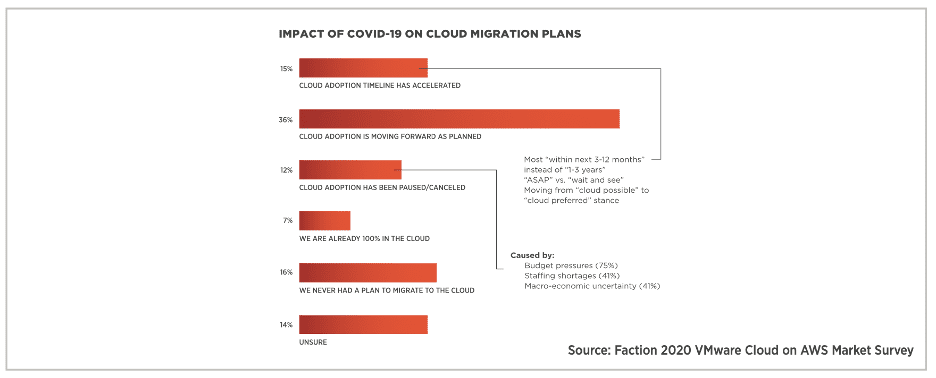At a time when COVID-19 is putting many IT plans and initiatives on hold, others are actually accelerating. Businesses of all sizes in varied fields are adapting to a host of new pressures. They’re adjusting to increased budgetary scrutiny, managing newly distributed workforces and modified workflows, finding new approaches to doing essential in-person work, such as in data centers, and innovating — quickly.
The pandemic is a key driver, not just of challenges but of the search for scalable solutions and cost savings that can meet these and other business needs. Enterprise cloud adoption, including interest in VMware Cloud on AWS, is growing in response to the new pressures of the COVID-19 era. These are among the findings of the 2020 VMware Cloud on AWS Market Survey — the second annual report about the use and adoption of the hybrid cloud platform that was released by in 2017.
BEHIND THE GROWING INTEREST IN 2021
Organizations that have already invested in VMware and cloud tools, system integrations, and staff training are often drawn to VMware Cloud on AWS for its ability to reduce operational overhead while accelerating cloud adoption. Based on the survey results, we can expect an increased rate of migration over the next 12 months. The percentage of respondents who plan to migrate in the next 12 months has increased to 28 percent, compared with 2019’s response of 23 percent. Meanwhile, 25 percent of respondents plan to add or increase workloads, 13 percent plan to start running workloads for the first time, and 12 percent plan to increase the number of workloads, all in the coming year.
The top driver behind this interest (for the second year in a row) is scalability, as reported by more than half of the survey participants. Other top drivers include strategic IT initiatives (49 percent), cost savings (44 percent), end of life hardware (33 percent), and closure of a data center (16 percent). Reasons for not considering VMware Cloud onAWS include planning to keep all IT resources on-premises for the foreseeable future, not seeing it as a good economic fit for current projects, or planning to use public clouds (like AWS or Azure) natively.

The interest is present across a range of industries and use cases. The fields showing the most interest are tech services, financial services, healthcare, and government. Where VMware Cloud on AWS is already running, the top use cases are data center extensions (26 percent), AWS integrated applications (22 percent), and cloud migrations (18 percent). Among organizations that are considering this move, the top use cases are data center extensions (25 percent), disaster recovery (23 percent), and testing and development (17 percent).
Another VMware resource poised for growth is the VMware Tanzu portfolio, an enterprise-ready suite of tools that helps enterprises build applications, run a common Kubernetes framework across multiple clouds, and use a single point of control to manage their complete footprint. VMware Tanzu is currently used by 1 percent of all respondents and 2 percent of enterprises (1,001-plus employees). An additional 18 percent of all respondents and 21 percent of enterprises plan to adopt VMware Tanzu over the next two years.
THE PANDEMIC’S IMPACT ON CLOUD MIGRATION PLANS
In response to COVID-19, 51 percent of all respondents in this 2020 survey and 59 percent of those considering this change are either accelerating their cloud adoption timeline or moving forward as planned. Acceleration may result in migrating more quickly, within three months to a year rather than 1–3 years, changing from a “wait and see” approach and moving as quickly as possible, or now considering cloud adoption as “preferred,” rather than just “possible.”
Among respondents that are considering VMware Cloud on AWS and who have accelerated their cloud adoption timelines in response to the pandemic, 42 percent plan to transition within the coming 12 months. For this group, scalability and cost savings (each cited by 52 percent) and strategic IT initiatives (51 percent) are the top drivers of interest. The top use cases are data center extensions (34 percent), testing and development (17 percent), and virtual desktops/applications (15 percent). Among the businesses for which COVID-19 paused or canceled cloud adoption, budget pressures, staffing shortages, and macro-economic uncertainty are the leading causes for putting cloud plans on hold.

HOW CAN THIS ADDRESS PANDEMIC CHALLENGES?
As companies respond to challenges brought on by the COVID-19 pandemic, VMware Cloud on AWS can help make the most of resources by:
- Easing Budget Constraints: It frees up your data center footprint, allowing you to get out of data centers. Use what you need, when you need it, instead of building for peak requirements. Scale-up rapidly when you need the extra resources, then dial it back down when you don’t.
- Leveraging the Skills You Already Have: It is a natural evolution of your own workforce’s skill sets. It allows you to use AWS-native services in the cloud and consistent management tools between your on-prem VMware data center and the cloud. By avoiding refactoring of VMware workloads or retraining employees, you’re able to maximize staff efficiency, particularly important when resources are tight.
- Supporting Your Distributed Workforce: With most or all of your staff working from home, new difficulties and opportunities present themselves. Having consistent dashboards for on-premises and cloud locations can ease collaboration and improve transparency.
EASE THE TRANSITION TO PUBLIC CLOUD
VMware Cloud on AWS facilitates a smooth transition to public cloud by providing consistency between on-premises cloud environments. Workload portability is supported by eliminating the need to change hypervisors. By allowing the use of existing and new apps within the VMware construct, it maximizes the native AWS services’ power. In these days of pandemic-driven change and uncertainty, services that ease the implementation of strategic business goals — including cloud adoption — are all the more important and appealing.
PR Archives: Latest, By Company, By Date